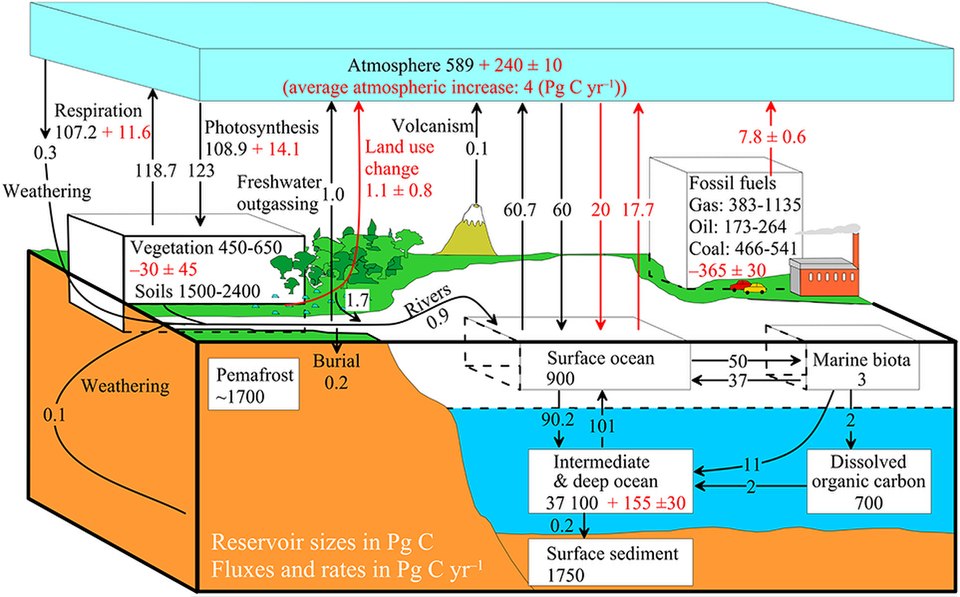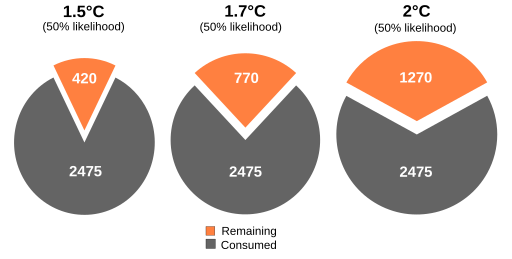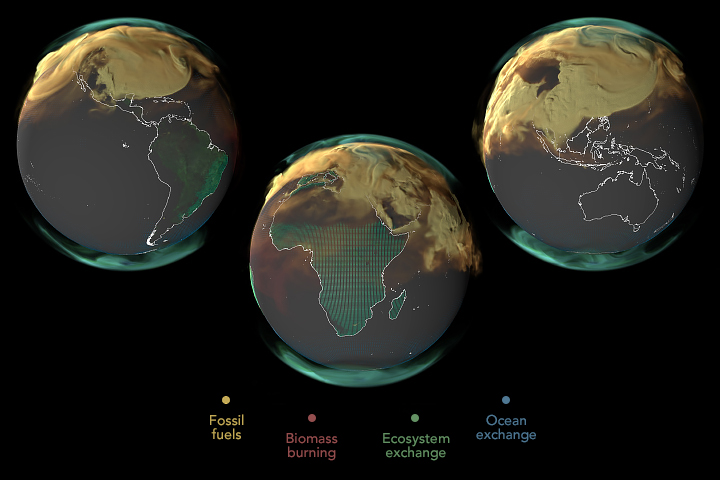AQA Specification focus:
‘The carbon budget and its impact on land, ocean, and atmosphere, including global climate.’
The carbon budget regulates Earth’s carbon distribution, influencing climate systems and environmental balance across land, oceans, and the atmosphere.
The Carbon Budget
The carbon budget refers to the balance of carbon exchanges (inputs and outputs) between the Earth’s carbon stores. It quantifies the maximum amount of carbon dioxide (CO₂) that can be emitted to keep global temperature rise within a particular threshold, such as 1.5°C or 2°C above pre-industrial levels. Maintaining this budget is vital for climate change mitigation.
Carbon Budget: The estimated amount of carbon dioxide emissions permitted over a period of time to keep within a certain temperature threshold.
The carbon budget accounts for:
Natural processes such as photosynthesis, respiration, decomposition, and oceanic absorption.
Human-induced processes like combustion of fossil fuels, land-use change, and industrial emissions.
Global Carbon Stores and Transfers
Carbon is stored in several key carbon reservoirs:
Lithosphere – carbon in fossil fuels and sedimentary rock.
Hydrosphere – dissolved carbon in oceans.
Biosphere – carbon within vegetation and soil.
Atmosphere – carbon dioxide and methane gases.
Carbon moves between these stores through processes like:
Photosynthesis: Removes CO₂ from the atmosphere into plants.
Respiration: Releases CO₂ back to the atmosphere from living organisms.
Decomposition: Breaks down organic material, returning carbon to soil and air.
Combustion: Burning of biomass or fossil fuels releases carbon.
Ocean uptake: CO₂ is absorbed by surface waters and transported into deep ocean layers.
These processes make up the global carbon cycle, and the balance among them defines the net carbon budget.

This diagram displays carbon stocks in petagrams (Pg C) and annual exchange fluxes between atmosphere, land, and ocean, with black arrows for pre-industrial values and red for anthropogenic flows. It labels reservoir masses and flux rates (Pg C yr⁻¹). These quantitative details go beyond the syllabus focus on the carbon budget and its impacts. Source
Impacts of the Carbon Budget on Land
The carbon budget influences terrestrial environments in various ways:
Carbon fertilisation effect: Elevated atmospheric CO₂ can stimulate plant growth by enhancing photosynthesis. This is especially observed in tropical and temperate forests.
Soil degradation: Long-term CO₂ increases and climate change can alter soil carbon content through increased microbial activity and erosion.
Deforestation and land-use change (e.g. conversion to agriculture) reduce the land’s carbon storage capacity, contributing to a positive feedback loop in global warming.
Positive Feedback Loop: A process in which an initial change leads to further change in the same direction, amplifying the original effect.
Impacts of the Carbon Budget on Oceans
The oceans are vital carbon sinks, absorbing nearly 25–30% of anthropogenic CO₂. However, excessive carbon input alters ocean chemistry:
Ocean acidification: CO₂ reacts with seawater forming carbonic acid, which reduces the pH of oceans, impacting marine organisms like coral reefs and shell-forming plankton.
Thermohaline circulation disruption: Changes in temperature and salinity caused by warming affect the ocean’s ability to transport heat and carbon.
Reduced biological pump efficiency: The ocean’s biological mechanisms (e.g. plankton uptake of carbon) become less effective as nutrient cycling is disturbed by warming waters.
Ocean Acidification: The ongoing decrease in the pH of the Earth's oceans, caused by the uptake of carbon dioxide from the atmosphere.
These changes reduce the ocean’s capacity to sequester carbon and contribute to sea level rise and marine biodiversity loss.
Impacts of the Carbon Budget on the Atmosphere
The atmospheric store of carbon, primarily in the form of CO₂ and methane (CH₄), is directly linked to global climate regulation:
Increased atmospheric CO₂ leads to enhanced greenhouse effect, trapping more outgoing longwave radiation and raising global temperatures.
Greater concentration of methane, a more potent greenhouse gas than CO₂, intensifies this warming despite its shorter atmospheric lifespan.
Altered precipitation patterns, more extreme weather events, and atmospheric circulation shifts are all linked to carbon budget imbalances.
Greenhouse Effect: The process by which greenhouse gases trap heat in the Earth’s atmosphere, keeping the planet warmer than it would otherwise be.
Climate Change and the Carbon Budget
The Intergovernmental Panel on Climate Change (IPCC) links the carbon budget to specific warming thresholds. For example:
To limit warming to 1.5°C, the global remaining carbon budget is around 500 GtCO₂, depending on model uncertainties.
Current annual global CO₂ emissions are over 36 GtCO₂, rapidly depleting this budget.

This pie chart from the Global Carbon Project shows the 2021 remaining carbon budget for a 1.5 °C threshold, partitioned into consumed and available portions. It presents the budget in gigatonnes of CO₂. The chart includes uncertainty bounds not required by the syllabus focus on budget concepts. Source

The hero image shows record fossil-fuel CO₂ emissions reaching 36.8 billion t in 2023, part of the annual Global Carbon Budget assessment. It visually emphasizes the rising emissions trend depleting the carbon budget. The page also features dynamic visualizations of CO₂ flows by source, beyond the static syllabus requirements. Source
Breaching the carbon budget leads to:
More frequent extreme weather events such as droughts, floods, and heatwaves.
Melting of ice caps and glaciers, contributing to sea level rise.
Positive climate feedbacks, such as permafrost thaw releasing methane, further amplifying warming.
Feedback Mechanisms Related to the Carbon Budget
The carbon budget is closely tied to feedback loops that either stabilise or destabilise the climate:
Positive feedback examples:
Melting permafrost releasing trapped methane and CO₂.
Forest dieback reducing the carbon sequestration capacity of the biosphere.
Negative feedback examples:
Increased vegetation growth under higher CO₂ levels may enhance carbon uptake in the short term.
Ocean circulation changes that sequester more carbon at depth (though often temporary).
Human Influence and Carbon Budget Management
Humans significantly influence the carbon budget through:
Fossil fuel combustion – the largest contributor to increased atmospheric CO₂.
Land use changes, especially deforestation.
Industrial activities, cement production, and agriculture (notably methane emissions from livestock and rice paddies).
Efforts to manage the carbon budget include:
Carbon capture and storage (CCS).
Afforestation and reforestation projects.
Transitioning to renewable energy sources to reduce dependency on fossil fuels.
These strategies aim to create a net-zero carbon state, where emissions are balanced by removals, helping to stabilise the climate system.
FAQ
There are several uncertainties that affect how accurately the carbon budget can be calculated:
Difficulty in measuring carbon fluxes, especially in remote or deep ocean regions.
Incomplete knowledge of feedback mechanisms, such as how permafrost thaw or forest dieback will respond to warming.
Variability in national emissions reporting and lack of transparency in some regions.
Assumptions made in climate models about climate sensitivity and carbon sinks.
These factors mean that published carbon budgets often include a range of values and confidence levels.
Land-use change includes more than tree removal. It also involves:
Urbanisation, which reduces vegetation cover and soil carbon storage.
Agricultural expansion, which can degrade soil carbon stocks through ploughing and fertiliser use.
Wetland drainage, which releases stored carbon from organic-rich soils.
Changes to land use can also disrupt local carbon balances and long-term sequestration capacity.
The carbon budget is a global measure of allowable emissions to stay within a climate target.
In contrast, the carbon footprint refers to the total emissions caused by an individual, organisation, or product across its lifecycle.
The carbon budget is a top-down scientific estimate.
The carbon footprint is a bottom-up measure of impact. Both are linked but serve different analytical and policy purposes.
Methane (CH₄) is far less abundant than CO₂, but:
It has a global warming potential (GWP) over 80 times greater than CO₂ over a 20-year period.
It contributes to short-term warming, which can accelerate feedbacks like permafrost melt.
Main sources include agriculture (e.g. cattle, rice paddies), fossil fuel extraction, and landfills.
Although it stays in the atmosphere for a shorter time, its potent warming effect makes it important in budget calculations.
Negative emissions technologies (NETs) aim to remove CO₂ from the atmosphere, helping to extend the remaining budget.
Common NETs include:
Direct Air Capture (DAC): chemically extracts CO₂ from ambient air.
Bioenergy with Carbon Capture and Storage (BECCS): burns biomass for energy, capturing and storing the emitted CO₂.
Afforestation and reforestation: increase biological uptake through tree planting.
Widespread deployment of NETs is viewed as essential in scenarios aiming to limit warming to 1.5°C or 2°C.
Practice Questions
Identify three stores in the global carbon cycle and state one example of each. (3 marks)
1 mark for each correctly identified store with an appropriate example.
Lithosphere – e.g. fossil fuels or sedimentary rock
Hydrosphere – e.g. dissolved CO₂ in oceans
Biosphere – e.g. vegetation or soil
Atmosphere – e.g. carbon dioxide or methane gas
(Any 3 from 4; must include correct pairing of store and example.) (3 marks)
Explain how changes to the carbon budget can affect both the oceans and the atmosphere. (6 marks)
Award up to 6 marks for explaining impacts on both oceans and atmosphere, with clear understanding of the carbon budget and relevant processes.
Indicative content:
Excess CO₂ in the atmosphere enhances the greenhouse effect, leading to global warming.
This can cause more extreme weather patterns, sea level rise, and shifts in climate zones.
Oceans absorb excess atmospheric CO₂, causing ocean acidification.
Acidification affects marine ecosystems, especially species that rely on calcium carbonate (e.g. coral reefs).
Warming oceans may also reduce the efficiency of the biological carbon pump, decreasing CO₂ absorption.
Methane increases from warming permafrost or agriculture further intensify atmospheric warming.
Marking guidance:
1–2 marks: Basic understanding with limited reference to impacts on oceans or atmosphere.
3–4 marks: Clear explanation of at least one sphere with partial detail on processes.
5–6 marks: Detailed explanation covering both spheres and showing clear understanding of carbon budget implications.
(6 marks)

